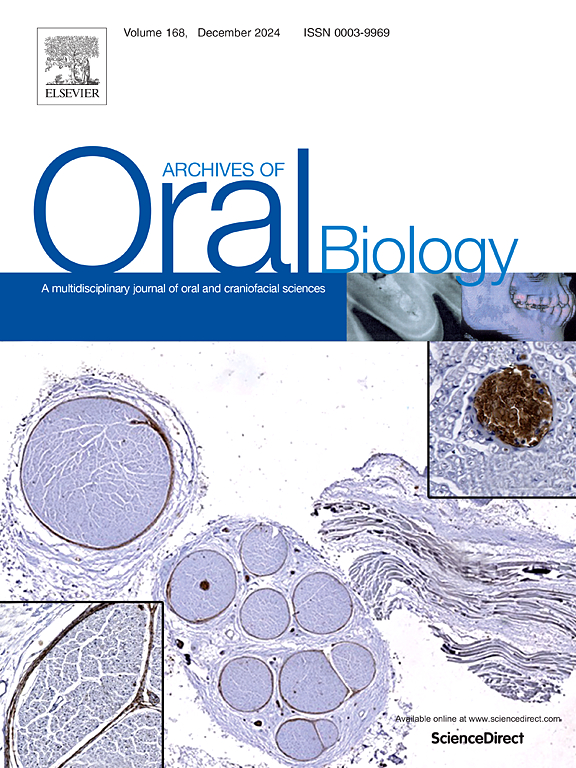Impact of mandibular overdentures on maxillary resorption and its association with masticatory function: A prospective longitudinal study with 3 years of follow-up
IF 2.2
4区 医学
Q2 DENTISTRY, ORAL SURGERY & MEDICINE
引用次数: 0
Abstract
Objective
This longitudinal clinical study monitored annually the maxillary and mandibular bone remodeling and masticatory function in complete denture (CD) wearers rehabilitated with implant-retained mandibular overdentures (MO) over three years and combined radiographic and masticatory function data to assess the correlation between bone remodeling and masticatory function.
Design
Thirty-nine MO wearers were monitored annually to assess changes in: i) residual ridge in the anterior and posterior maxillary region; ii) posterior height and posterior area index (PAI) in the mandible; and iii) masticatory function. Bone remodeling was measured through linear and angular measurements using panoramic radiographs. Masticatory function was evaluated by swallowing threshold test, to determine the median particle size (X50) and homogenization index (B). A mixed-effects multilevel regression model estimated differences between radiological and masticatory parameters over time, with associations verified using Pearson's correlation test.
Results
Significant changes in mandibular bone variables (PAI and L1/R1, L2/R2, L3/R3; p ≤ 0.01) occurred when transitioning from CD to MO, showing a reduction in PAI values and slight reduction in mandibular linear measurements. Improvements in masticatory parameters were also observed, highlighting the benefits of transitioning to MO. Over three years of MO usage, significant changes in all radiographic bone parameters were found, with increased PAI and maxillary bone values in the first year. The correlations between masticatory function and radiological parameters indicated that mandibular morphology can significantly influence masticatory function especially in patients wearing CDs. Following the transition to MO, only one consistent significant correlation was observed between X50 and R3/L3 at the 1-year and 3-year intervals.
Conclusion
Continuous changes in bone parameters were observed in MO wearers, with stabilization of maxillary ridge resorption and ongoing mandibular remodeling, alongside slight changes in masticatory function, suggesting transitory correlations between linear changes in the posterior region of mandible and masticatory function over time.
下颌覆盖义齿对上颌吸收的影响及其与咀嚼功能的关系:一项为期3年随访的前瞻性纵向研究。
目的:本研究对全口义齿(CD)下颌种植覆盖义齿(MO)康复患者进行为期三年的上颌骨重塑和咀嚼功能监测,并结合影像学和咀嚼功能数据评估骨重塑与咀嚼功能的相关性。设计:每年对39名MO佩戴者进行监测,以评估以下方面的变化:i)上颌前后区残余脊;ii)下颌骨后高和后面积指数(PAI);咀嚼功能。采用全景x线片进行线性和角度测量,测量骨重塑。通过吞咽阈值试验评估咀嚼功能,以确定中位粒径(X50)和均质化指数(B)。混合效应多水平回归模型估计放射学和咀嚼参数随时间的差异,并使用Pearson相关检验验证相关性。结果:下颌骨变量(PAI、L1/R1、L2/R2、L3/R3)发生显著变化;p ≤ 0.01)发生在从CD过渡到MO时,显示PAI值降低,下颌线性测量略有降低。咀嚼参数的改善也被观察到,突出了过渡到MO的好处。在使用MO的三年中,所有x线骨参数都发生了显著变化,第一年PAI和上颌骨值增加。咀嚼功能与影像学参数的相关性表明,下颌形态对咀嚼功能有显著影响,尤其是佩戴cd的患者。在向MO过渡后,仅在1年和3年的间隔内观察到X50与R3/L3之间存在一致的显著相关性。结论:MO佩戴者的骨参数持续变化,上颌嵴吸收稳定,下颌重塑持续,咀嚼功能轻微变化,提示下颌骨后区线性变化与咀嚼功能随时间的短暂相关性。
本文章由计算机程序翻译,如有差异,请以英文原文为准。
求助全文
约1分钟内获得全文
求助全文
来源期刊

Archives of oral biology
医学-牙科与口腔外科
CiteScore
5.10
自引率
3.30%
发文量
177
审稿时长
26 days
期刊介绍:
Archives of Oral Biology is an international journal which aims to publish papers of the highest scientific quality in the oral and craniofacial sciences. The journal is particularly interested in research which advances knowledge in the mechanisms of craniofacial development and disease, including:
Cell and molecular biology
Molecular genetics
Immunology
Pathogenesis
Cellular microbiology
Embryology
Syndromology
Forensic dentistry
 求助内容:
求助内容: 应助结果提醒方式:
应助结果提醒方式:


